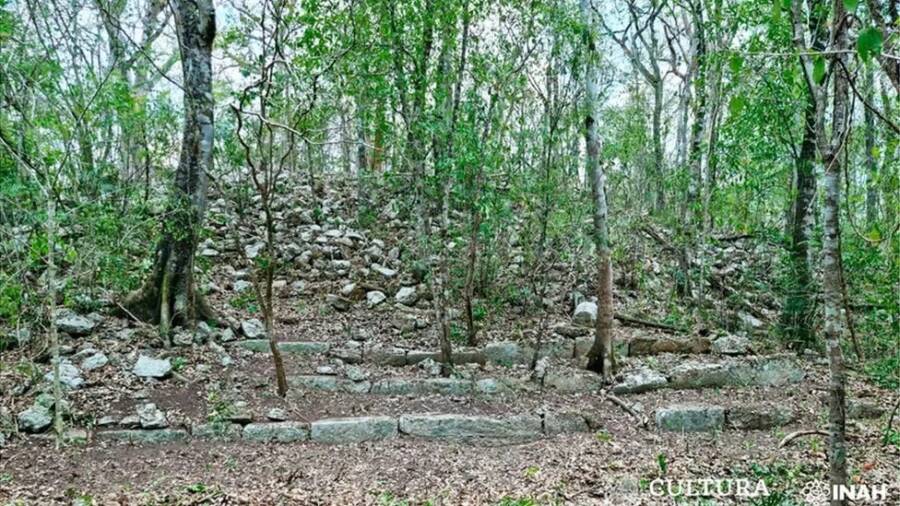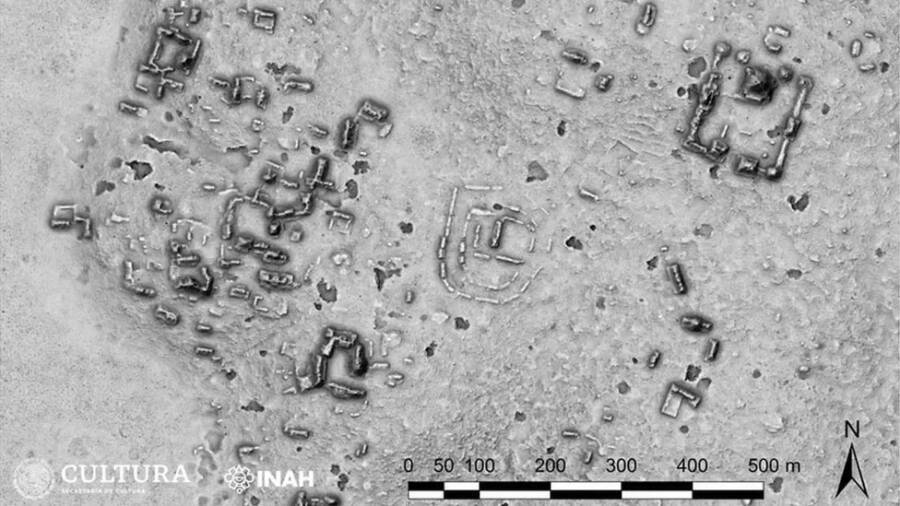The ruins, named Ocomtún, date back to the time of the collapse of Maya civilization in the Yucatán lowlands.

Ivan Šprajc/INAHThe remains of a Maya building at the Ocomtún site, featuring stone steps.
A team of archaeologists from Mexico’s National Institute of Anthropology and History (INAH) working in the Balamkú ecological reserve on the Yucatán Peninsula recently discovered the 1,000-year-old remains of an ancient Maya city.
In a statement, lead archaeologist Ivan Šprajc expanded on the discovery, saying that the team first discovered several large stone columns at the site, as well as pyramids and a court used for ball games.
The team named the newly discovered ruins Ocomtún, meaning “stone column” in Yucatec Mayan, after the columns found throughout the site. This discovery was made possible in part due to an airborne laser scan (LiDAR) conducted by the National Center for Airborne Laser Mapping at the University of Houston, which enabled researchers to identify numerous concentrations of pre-Hispanic structures across the Yucatán Peninsula.
This mapping allowed Šprajc’s team to pinpoint the Ocomtún site, noting that while it shares many characteristics with contemporary Maya sites, it also had several contrasting peculiarities that distinguish it.
“The biggest surprise turned out to be the site located on a ‘peninsula’ of high ground, surrounded by extensive wetlands,” Šprajc said in the translated statement. “Its monumental nucleus covers more than 50 hectares (123 acres) and has various large buildings, including several pyramidal structures more than 15 meters (around 50 feet) high.”
Šprajc said that the site was likely an important regional center during the Classic period spanning from 250 to 1000 C.E., although more detailed data will come after an in-depth analysis of ceramic samples gathered at the site.
The pyramids within the Ocomtún ruins served religious and spiritual purposes for the Maya people, with large, stepped pyramids being utilized for ceremonies, rituals, and sacrifices. Šprajc noted that the multiple stone columns around Ocomtún likely formed part of the entrances to upper rooms in the buildings that once stood on the site.

Ivan Šprajc/INAHA stone column found at Ocomtún, for which the city is named.
Alongside these structures, INAH archaeologists also found various ceramics, three separate plazas, several courtyards “made up of various low and elongated structures, arranged almost in concentric circles,” and a court where the Maya people would have played ball games such as pelota.
Pelota was a popular team sport throughout ancient Mesoamerican cultures that saw players adorned in layers of protective padding moving large rubber balls competitively from one end of a court to the other, not dissimilar to most modern sports. However, although pelota was undoubtedly a form of entertainment, many historians believe the sport also served symbolic and spiritual purposes, with the ball’s movement across the court representing the movement of the sun across the sky.
Surviving texts also illustrate that pelota served as the setting for mythological battles between the forces of life and death. Recent research also shows that Maya rulers’ ashes may have been used in the ball-making process as a way of having them live on again after death.
This insight and the Ocomtún discovery come as part of a larger INAH project seeking to survey the Yucatán Peninsula. This large, central forest region covers parts of Mexico, Belize, and Guatemala.
Šprajc additionally noted how certain remnants found at the Ocomtún site, such as shrines and the centers of courtyards and squares, can serve as a “reflection of ideological and population changes in times of crises that, finally, by the 10th century, led to the collapse of the complex sociopolitical organization and the drastic demographic decline in the Maya Central Lowlands.”
These indicators at Ocomtún are representative of the much broader collapse of the Maya civilization, which, as described by a 2012 article from Smithsonian Magazine, saw “dozens of core urban areas in the lowlands of the Yucatán Peninsula” go from “bustling cities to abandoned ruins.”

INAHLiDAR map of the Ocomtún site.
This collapse of the Maya civilization, from around 800 to 1000 C.E., was due to a number of factors, with most historians suggesting that the main contributors were a prolonged drought and deforestation. Studies have since found that Maya societies were seeing a dramatic decrease in rainfall. As Maya people cleared more and more forest to make room for agriculture, they limited their own resources.
Other studies examined these trends and applied quantitative data to them, using population records and measurements from modern forested lands to construct a computer model of historical deforestation in the Yucatán, running simulations to see how this may have contributed further to the decrease in rainfall.
Maya civilization was also reaching an unprecedented population density, and the result was catastrophic when combined with drought and deforestation.
Ocomtún’s ruins are particularly notable in that they serve as a snapshot of this period, offering researchers a clearer glimpse into the downfall of Maya culture in the Yucatán Lowlands.
After learning about this newly discovered Maya city, read about what finally ended the Maya empire. Or, read about Camazotz, the ancient Maya bat god.





